Lily
-
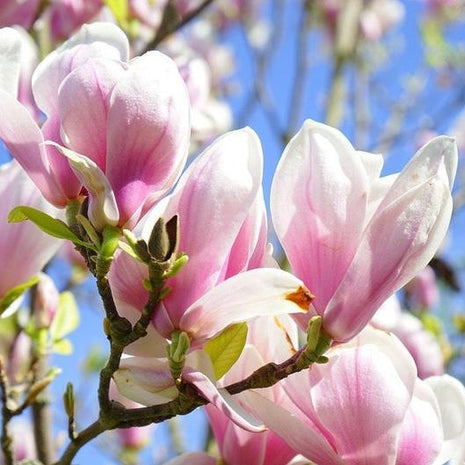

safh456 20pcs LILY MAGNOLIA Flower TREE Pink & Purple Fragrant Tulip Magnol Liliiflora Seeds
DESCRIPTION: NAME: Lily Magnolia OTHER COMMON NAMES: Mulan Magnolia / Purple Magnolia / Red Magnolia / Tulip Magnolia SCIENTIFIC NAME: Magnolia Liliiflora syn. Yulania Liliiflora COLOR: Pink & Purple PLANT SEEDS: Fall sow seeds or cold stratify BLOOM TIME: April - June HARDINESS ZONE: 5 - 9 PLANT HEIGHT: 10 - 14' PLANT SPACING: 15 - 20' LIGHT REQUIREMENTS: Sun - Part Shade SOIL & WATER PREFERENCES: Average QUANTITY: 20 Seeds OTHER: The Lily Magnolia is a very ornamental shrub to small tree originally from China. They have colorful flower buds in the early spring. & flowers that bloom before the leaves open. The huge 3” fragrant flowers absolutely smother the plant perfuming the air. The Lily Magnolia has a long bloom time. & can bloom again or all the way through fall in warmer climates!
$5.99
-
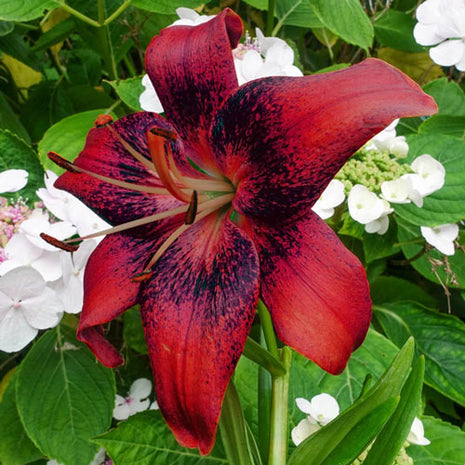
GardenerStar Strawberry Event Lily
Strawberry Event boasts some of the biggest and brightest lilies of its kind. It gladly offers up its 5–7" bright red flowers on stately stems that reach an impressive 4' tall. making them ideal for back borders or cutting gardens. A liberal sprinkling of black freckles dot each lily's face and. combined with slightly reflexed petals. give the bloom a highly dimensional look. A must for the discerning gardener or anyone who enjoys elegant flowers in a decidedly dramatic hue. And thanks to Strawberry Event's strong growth habit. there are plenty of blooms to be had. Botanical Name: Lilium asiatic 'Strawberry Event' Form: Bulb Hardiness Zone: 3-8 Flowering Time: Early to midsummer Light Requirements: Full Sun. Partial Shade Flower Color: Bright red flowers with peppered black Flower Form: 5-7" sideways facing flowers with the typical lily-shape. Petals gracefully curve backwards. Foliage Type: Narrow. long lance-shaped leaves. Height/Habit: 4 feet Spread: 9 - 12 inches Planting Instructions: 6" deep and 9-12" apart Soil Requirements: Prefers well drained soil. but will tolerate heavier soils. Will Tolerate: Acidic Soil. Clay Soil. Loamy Soil. Sandy Soil Pruning:Don't remove leaves until they have died down in fall. They help provide nourishment to the bulb for next season's blooms.
$4.99
-
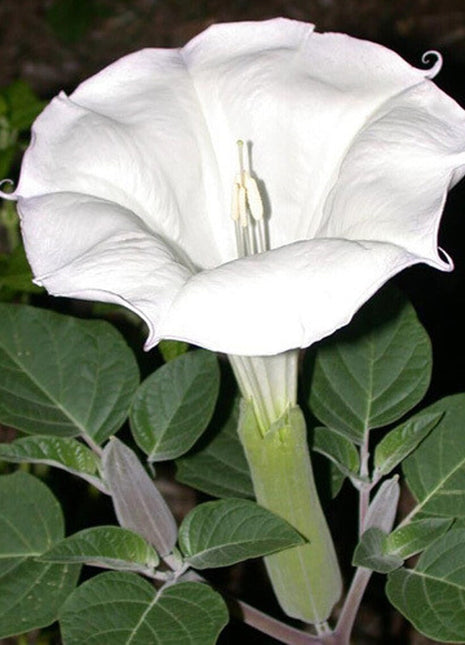
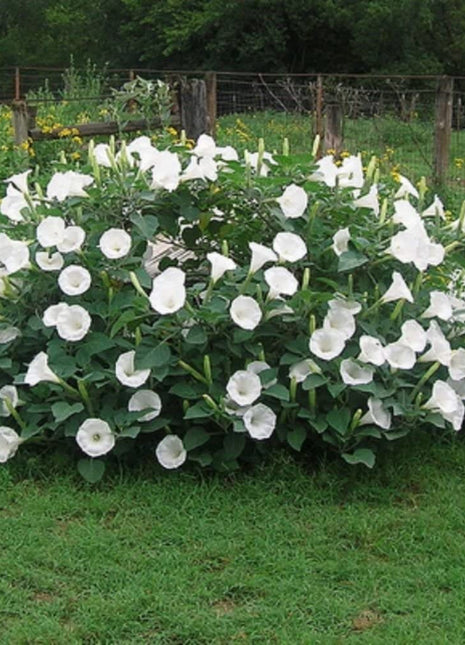
My Store Sacred Datura Moonflower Moon Lily Angel's Trumpet Flower Premium Seeds Packet
Description: 10 seeds per packet Since I was a child. I've had these growing in my garden. I remember my great grandmom giving my mom some of the seedlings and watching them grow into these handsome plants with gorgeous. giant white blooms that open at dusk with heavenly fragrance. Honeybees actually line up on the outside of the petals before they pop open! It's fun to watch. Can be a perennial in the right conditions. Here in Pennsylvania. ours come back year to year.
$17.98 $8.99
-
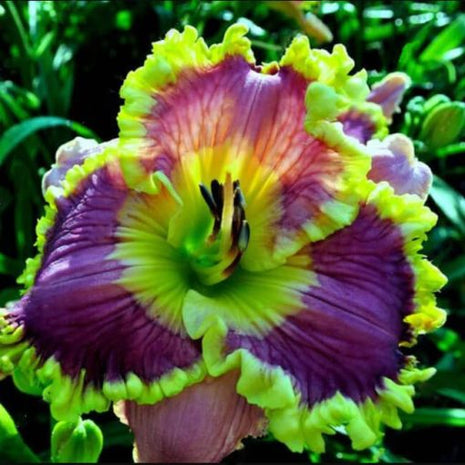
GardenerStar Daylily Hybrid Flowers Seed
Make Your Seed to Garden 1. Choose the right containers You can start seeds in almost any type of container. as long as it's at least 2-3 ” deep and has some drainage holes. If you love to DIY by yourself. you might start growing seedlings in yogurt cups. milk cartons or even a paper cup. 2. The “potting soil” Choose the potting soil that's made for growing seedlings. NOTE: Do not use soil from your garden or re-use potting soil from your houseplants. Start with a fresh. sterile mix that will ensure healthy. disease-free seedlings. 3. Planting Some of the small ones can be sprinkled right on the soil surface. Larger seeds will need to be buried. After planting seeds. you have to moisten the newly planted seeds. To speed up germination. cover the pots with wet paper or a plastic dome. This helps keep the seeds moist before they germinate. When you see the first signs of green. you have to remove the cover. 4. Watering. feeding. repeating As the seedlings grow up. you have to keep the soil moist but not soggy. Let the soil dry slightly between waterings. Remember to feed the seedlings regularly with liquid fertilizer. 5. Light Seeds need a lot of light. Set the lights on a timer for 15 hours a day. If you're growing in a window. choose a south-facing exposure. Rotate the pots regularly to keep plants from leaning into the light. If you're growing under lights. adjust them so they're just a few inches above the tops of the seedlings. Keep in mind that seedlings need darkness. too. so they can rest. As the seedlings grow taller. raise the lights. 6. Move to outdoors It's not a good idea to move your seedlings directly from the protected environment of your home into the garden. You've been coddling these seedlings for weeks. so they need a gradual transition to the great outdoors. About a week before you plan to set the seedlings into the garden. place them in a protected spot outdoors (partly shaded. out of the wind) for a few hours. bringing them in at night. Gradually. over the course of a week or 10 days. expose them to more and more sunshine and wind. A cold frame is a great place to harden off plants.
$5.99
-
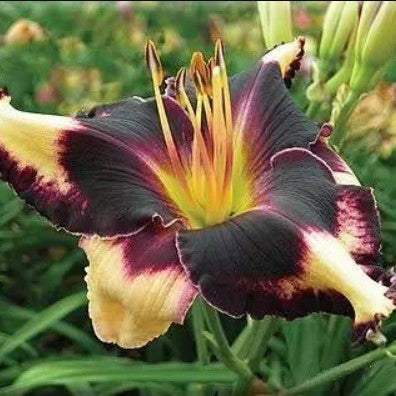
GardenerStar Daylily Hybrid Flowers Seeds
Make Your Seed to Garden 1. Choose the right containers You can start seeds in almost any type of container. as long as it's at least 2-3 ” deep and has some drainage holes. If you love to DIY by yourself. you might start growing seedlings in yogurt cups. milk cartons or even a paper cup. 2. The “potting soil” Choose the potting soil that's made for growing seedlings. NOTE: Do not use soil from your garden or re-use potting soil from your houseplants. Start with a fresh. sterile mix that will ensure healthy. disease-free seedlings. 3. Planting Some of the small ones can be sprinkled right on the soil surface. Larger seeds will need to be buried. After planting seeds. you have to moisten the newly planted seeds. To speed up germination. cover the pots with wet paper or a plastic dome. This helps keep the seeds moist before they germinate. When you see the first signs of green. you have to remove the cover. 4. Watering. feeding. repeating As the seedlings grow up. you have to keep the soil moist but not soggy. Let the soil dry slightly between waterings. Remember to feed the seedlings regularly with liquid fertilizer. 5. Light Seeds need a lot of light. Set the lights on a timer for 15 hours a day. If you're growing in a window. choose a south-facing exposure. Rotate the pots regularly to keep plants from leaning into the light. If you're growing under lights. adjust them so they're just a few inches above the tops of the seedlings. Keep in mind that seedlings need darkness. too. so they can rest. As the seedlings grow taller. raise the lights. 6. Move to outdoors It's not a good idea to move your seedlings directly from the protected environment of your home into the garden. You've been coddling these seedlings for weeks. so they need a gradual transition to the great outdoors. About a week before you plan to set the seedlings into the garden. place them in a protected spot outdoors (partly shaded. out of the wind) for a few hours. bringing them in at night. Gradually. over the course of a week or 10 days. expose them to more and more sunshine and wind. A cold frame is a great place to harden off plants.
$5.99
-
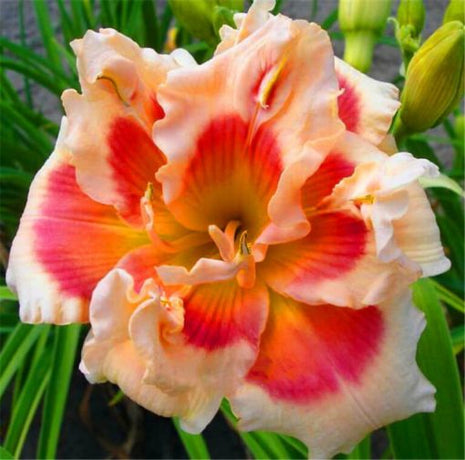
GardenerStar Daylily Hybrid Flowers Seed
Make Your Seed to Garden 1. Choose the right containers You can start seeds in almost any type of container. as long as it's at least 2-3 ” deep and has some drainage holes. If you love to DIY by yourself. you might start growing seedlings in yogurt cups. milk cartons or even a paper cup. 2. The “potting soil” Choose the potting soil that's made for growing seedlings. NOTE: Do not use soil from your garden or re-use potting soil from your houseplants. Start with a fresh. sterile mix that will ensure healthy. disease-free seedlings. 3. Planting Some of the small ones can be sprinkled right on the soil surface. Larger seeds will need to be buried. After planting seeds. you have to moisten the newly planted seeds. To speed up germination. cover the pots with wet paper or a plastic dome. This helps keep the seeds moist before they germinate. When you see the first signs of green. you have to remove the cover. 4. Watering. feeding. repeating As the seedlings grow up. you have to keep the soil moist but not soggy. Let the soil dry slightly between waterings. Remember to feed the seedlings regularly with liquid fertilizer. 5. Light Seeds need a lot of light. Set the lights on a timer for 15 hours a day. If you're growing in a window. choose a south-facing exposure. Rotate the pots regularly to keep plants from leaning into the light. If you're growing under lights. adjust them so they're just a few inches above the tops of the seedlings. Keep in mind that seedlings need darkness. too. so they can rest. As the seedlings grow taller. raise the lights. 6. Move to outdoors It's not a good idea to move your seedlings directly from the protected environment of your home into the garden. You've been coddling these seedlings for weeks. so they need a gradual transition to the great outdoors. About a week before you plan to set the seedlings into the garden. place them in a protected spot outdoors (partly shaded. out of the wind) for a few hours. bringing them in at night. Gradually. over the course of a week or 10 days. expose them to more and more sunshine and wind. A cold frame is a great place to harden off plants.
$5.99
-
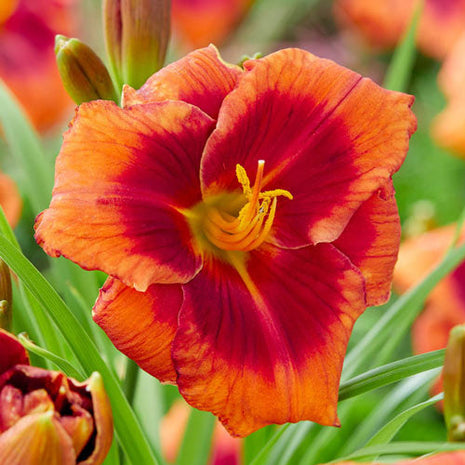
GardenerStar Frank Smith Reblooming Daylily
Extra-early blooms begin the season with a bang!Beautifully formed. 5" daylilies in a bold shade of orange feature a striking red eye zone and yellow to green throat. It appears in the landscape earlier than most daylilies. A light fragrance attracts butterflies and gives you one more reason to frequent the garden—as if you needed one. Botanical Name: Hemerocallis 'Frank Smith' Form: Perennial Hardiness Zone: 3-9 Flowering Time: Extra early season. and again in late summer to early fall. (Late spring. and again in late summer to early fall.) Light Requirements: Full Sun. Partial Shade Flower Color: Orange with a brilliant red eyezone and a yellow to green throat Flower Form: 5" single flower. Foliage Type: Evergreen grass-like. linear. long foliage. Growth Rate: Medium Height/Habit: 24 inches Spread: 18 - 24 inches Planting Instructions: Dig a hole deep enough to accommodate the roots without bending them. Roots should be just below the soil surface with the crown at the soil level. Will Tolerate: Acidic Soil. Clay Soil. Loamy Soil. Sandy Soil Pruning: Cut back spent flower stems after flowering.
$6.99
-
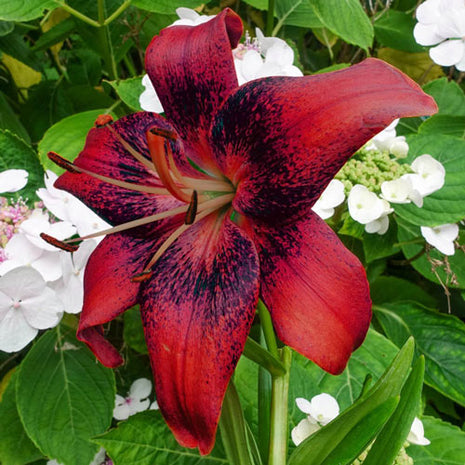
GardenerStar Strawberry Event Lily
Strawberry Event boasts some of the biggest and brightest lilies of its kind. It gladly offers up its 5–7" bright red flowers on stately stems that reach an impressive 4' tall. making them ideal for back borders or cutting gardens. A liberal sprinkling of black freckles dot each lily's face and. combined with slightly reflexed petals. give the bloom a highly dimensional look. A must for the discerning gardener or anyone who enjoys elegant flowers in a decidedly dramatic hue. And thanks to Strawberry Event's strong growth habit. there are plenty of blooms to be had. Botanical Name: Lilium asiatic 'Strawberry Event' Form: Bulb Hardiness Zone: 3-8 Flowering Time:Early to midsummer Light Requirements: Full Sun. Partial Shade Flower Color: Bright red flowers with peppered black Flower Form: 5-7" sideways facing flowers with the typical lily-shape. Petals gracefully curve backwards. Foliage Type: Narrow. long lance-shaped leaves. Growth Rate: Medium Height/Habit: 4 feet Spread: 9 - 12 inches Planting Instructions: 6" deep and 9-12" apart Soil Requirements: Prefers well drained soil. but will tolerate heavier soils. Will Tolerate: Acidic Soil. Clay Soil. Loamy Soil. Sandy Soil Pruning: Don't remove leaves until they have died down in fall. They help provide nourishment to the bulb for next season's blooms.
$4.99
-
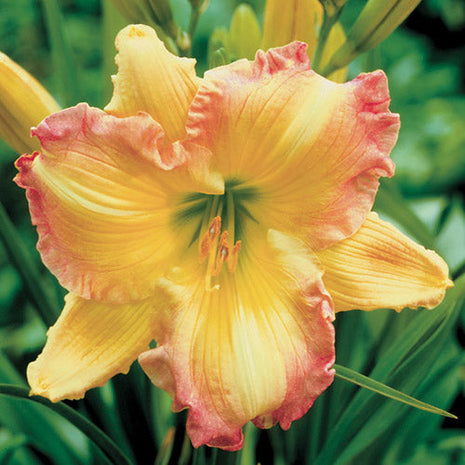
GardenerStar Daylily Hybrid Flowers Seed
Make Your Seed to Garden 1. Choose the right containers You can start seeds in almost any type of container. as long as it's at least 2-3 ” deep and has some drainage holes. If you love to DIY by yourself. you might start growing seedlings in yogurt cups. milk cartons or even a paper cup. 2. The “potting soil” Choose the potting soil that's made for growing seedlings. NOTE: Do not use soil from your garden or re-use potting soil from your houseplants. Start with a fresh. sterile mix that will ensure healthy. disease-free seedlings. 3. Planting Some of the small ones can be sprinkled right on the soil surface. Larger seeds will need to be buried. After planting seeds. you have to moisten the newly planted seeds. To speed up germination. cover the pots with wet paper or a plastic dome. This helps keep the seeds moist before they germinate. When you see the first signs of green. you have to remove the cover. 4. Watering. feeding. repeating As the seedlings grow up. you have to keep the soil moist but not soggy. Let the soil dry slightly between waterings. Remember to feed the seedlings regularly with liquid fertilizer. 5. Light Seeds need a lot of light. Set the lights on a timer for 15 hours a day. If you're growing in a window. choose a south-facing exposure. Rotate the pots regularly to keep plants from leaning into the light. If you're growing under lights. adjust them so they're just a few inches above the tops of the seedlings. Keep in mind that seedlings need darkness. too. so they can rest. As the seedlings grow taller. raise the lights. 6. Move to outdoors It's not a good idea to move your seedlings directly from the protected environment of your home into the garden. You've been coddling these seedlings for weeks. so they need a gradual transition to the great outdoors. About a week before you plan to set the seedlings into the garden. place them in a protected spot outdoors (partly shaded. out of the wind) for a few hours. bringing them in at night. Gradually. over the course of a week or 10 days. expose them to more and more sunshine and wind. A cold frame is a great place to harden off plants.
$5.99
-
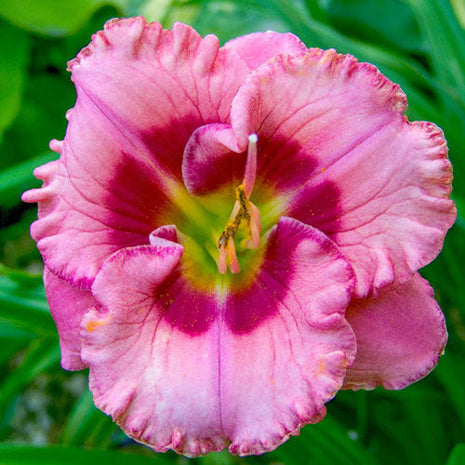
GardenerStar Cherry Valentine Reblooming Daylily
Gorgeous. floriferous and fragrant rebloomer!Each day is Valentine's Day when this plant's romantic-looking. bright pink with crimson red flowers are in bloom. With a stem that bears 30 buds on its three stems. you'll get lots of 4" flowers of bright pink with a crimson-red eye zone surrounding a green throat. A red edge beautifully outlines each bloom. Botanical Name: Hemerocallis 'Cherry Valentine' Form: Root (perennial) Hardiness Zone: 3-9 Flowering Time: Early season and again in late summer to early fall. Light Requirements: Full Sun. Partial Shade Flower Color: Bright pink with crimson red eyezone above green throat Flower Form: 4" single flower. Tetraploid. Foliage Type: Evergreen grass-like. linear foliage. Growth Rate: Medium Height/Habit: 28 inches Spread: 24 inches Planting Instructions: Soak roots for half an hour in cold to luke warm water. Dig a hole deep enough to accommodate the roots without bending them. Plant with the crown (sprouts) just below soil level. Soil Requirements: Well drained Will Tolerate: Acidic Soil. Clay Soil. Loamy Soil. Sandy Soil Pruning: Cut back spent flower stems after flowering.
$5.99
-
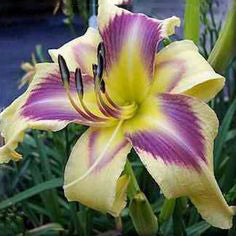
GardenerStar Daylily Hybrid Flowers Seed
Make Your Seed to Garden 1. Choose the right containers You can start seeds in almost any type of container. as long as it's at least 2-3 ” deep and has some drainage holes. If you love to DIY by yourself. you might start growing seedlings in yogurt cups. milk cartons or even a paper cup. 2. The “potting soil” Choose the potting soil that's made for growing seedlings. NOTE: Do not use soil from your garden or re-use potting soil from your houseplants. Start with a fresh. sterile mix that will ensure healthy. disease-free seedlings. 3. Planting Some of the small ones can be sprinkled right on the soil surface. Larger seeds will need to be buried. After planting seeds. you have to moisten the newly planted seeds. To speed up germination. cover the pots with wet paper or a plastic dome. This helps keep the seeds moist before they germinate. When you see the first signs of green. you have to remove the cover. 4. Watering. feeding. repeating As the seedlings grow up. you have to keep the soil moist but not soggy. Let the soil dry slightly between waterings. Remember to feed the seedlings regularly with liquid fertilizer. 5. Light Seeds need a lot of light. Set the lights on a timer for 15 hours a day. If you're growing in a window. choose a south-facing exposure. Rotate the pots regularly to keep plants from leaning into the light. If you're growing under lights. adjust them so they're just a few inches above the tops of the seedlings. Keep in mind that seedlings need darkness. too. so they can rest. As the seedlings grow taller. raise the lights. 6. Move to outdoors It's not a good idea to move your seedlings directly from the protected environment of your home into the garden. You've been coddling these seedlings for weeks. so they need a gradual transition to the great outdoors. About a week before you plan to set the seedlings into the garden. place them in a protected spot outdoors (partly shaded. out of the wind) for a few hours. bringing them in at night. Gradually. over the course of a week or 10 days. expose them to more and more sunshine and wind. A cold frame is a great place to harden off plants.
$5.99
-
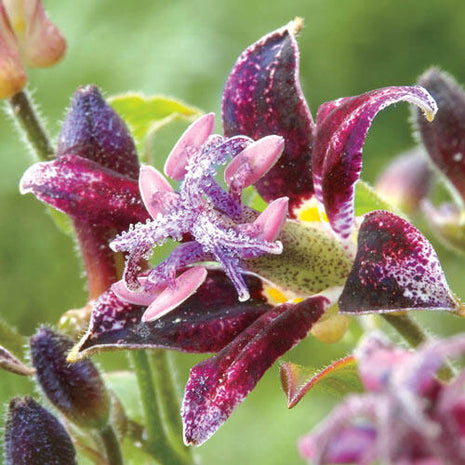
GardenerStar Raspberry Mousse Toad Lily
This vigorous grower sports star-shaped. petite. rich red-purple blooms. Ladderlike leaves alternate up slender stems. Perfect for a woodland setting! Easily adaptable. they tolerate a wide range of soil conditions. Botanical Name: Tricyrtis hirta 'Raspberry Mousse' PP16257 Form: Perennial Hardiness Zone: 5-9 Flowering Time: Late summer to early fall Light Requirements: Partial Shade. Full Shade Flower Color: Dark red-purple blooms almost solid coloring - no spots or freckling. Flower Form: Orchid like flowers Foliage Type: Dark to pale green. ladder like leaves. lanceolate shape Growth Rate: Medium Height/Habit: 18 - 24 inches Spread: 18 - 24 inches Planting Instructions: Plant even with soil level and 18-24" apart Soil Requirements: Well drained Will Tolerate: Acidic Soil. Clay Soil. Loamy Soil. Sandy Soil Pruning: Not needed
$6.99
-
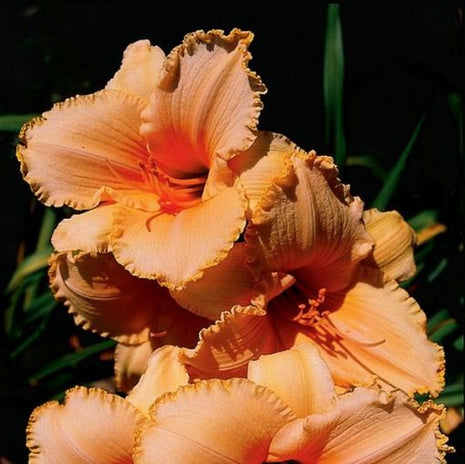
GardenerStar Daylily Hybrid Flowers Seed
Make Your Seed to Garden 1. Choose the right containers You can start seeds in almost any type of container. as long as it's at least 2-3 ” deep and has some drainage holes. If you love to DIY by yourself. you might start growing seedlings in yogurt cups. milk cartons or even a paper cup. 2. The “potting soil” Choose the potting soil that's made for growing seedlings. NOTE: Do not use soil from your garden or re-use potting soil from your houseplants. Start with a fresh. sterile mix that will ensure healthy. disease-free seedlings. 3. Planting Some of the small ones can be sprinkled right on the soil surface. Larger seeds will need to be buried. After planting seeds. you have to moisten the newly planted seeds. To speed up germination. cover the pots with wet paper or a plastic dome. This helps keep the seeds moist before they germinate. When you see the first signs of green. you have to remove the cover. 4. Watering. feeding. repeating As the seedlings grow up. you have to keep the soil moist but not soggy. Let the soil dry slightly between waterings. Remember to feed the seedlings regularly with liquid fertilizer. 5. Light Seeds need a lot of light. Set the lights on a timer for 15 hours a day. If you're growing in a window. choose a south-facing exposure. Rotate the pots regularly to keep plants from leaning into the light. If you're growing under lights. adjust them so they're just a few inches above the tops of the seedlings. Keep in mind that seedlings need darkness. too. so they can rest. As the seedlings grow taller. raise the lights. 6. Move to outdoors It's not a good idea to move your seedlings directly from the protected environment of your home into the garden. You've been coddling these seedlings for weeks. so they need a gradual transition to the great outdoors. About a week before you plan to set the seedlings into the garden. place them in a protected spot outdoors (partly shaded. out of the wind) for a few hours. bringing them in at night. Gradually. over the course of a week or 10 days. expose them to more and more sunshine and wind. A cold frame is a great place to harden off plants.
$5.99
-
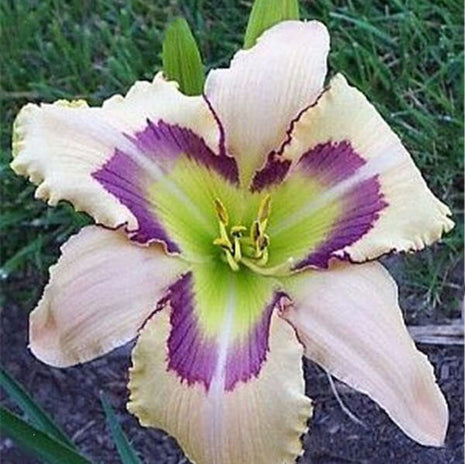
GardenerStar Daylily Hybrid Flowers Seed
Make Your Seed to Garden 1. Choose the right containers You can start seeds in almost any type of container. as long as it's at least 2-3 ” deep and has some drainage holes. If you love to DIY by yourself. you might start growing seedlings in yogurt cups. milk cartons or even a paper cup. 2. The “potting soil” Choose the potting soil that's made for growing seedlings. NOTE: Do not use soil from your garden or re-use potting soil from your houseplants. Start with a fresh. sterile mix that will ensure healthy. disease-free seedlings. 3. Planting Some of the small ones can be sprinkled right on the soil surface. Larger seeds will need to be buried. After planting seeds. you have to moisten the newly planted seeds. To speed up germination. cover the pots with wet paper or a plastic dome. This helps keep the seeds moist before they germinate. When you see the first signs of green. you have to remove the cover. 4. Watering. feeding. repeating As the seedlings grow up. you have to keep the soil moist but not soggy. Let the soil dry slightly between waterings. Remember to feed the seedlings regularly with liquid fertilizer. 5. Light Seeds need a lot of light. Set the lights on a timer for 15 hours a day. If you're growing in a window. choose a south-facing exposure. Rotate the pots regularly to keep plants from leaning into the light. If you're growing under lights. adjust them so they're just a few inches above the tops of the seedlings. Keep in mind that seedlings need darkness. too. so they can rest. As the seedlings grow taller. raise the lights. 6. Move to outdoors It's not a good idea to move your seedlings directly from the protected environment of your home into the garden. You've been coddling these seedlings for weeks. so they need a gradual transition to the great outdoors. About a week before you plan to set the seedlings into the garden. place them in a protected spot outdoors (partly shaded. out of the wind) for a few hours. bringing them in at night. Gradually. over the course of a week or 10 days. expose them to more and more sunshine and wind. A cold frame is a great place to harden off plants.
$5.99
-
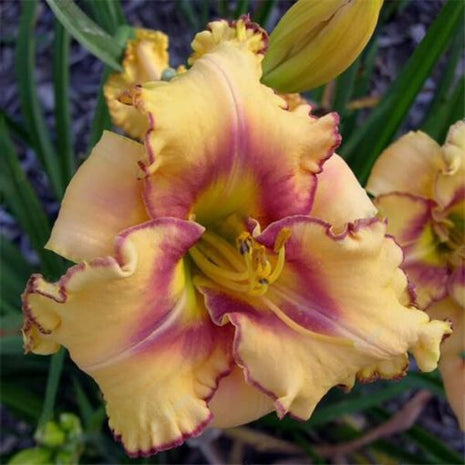
GardenerStar Daylily Hybrid Flowers Seed
Make Your Seed to Garden 1. Choose the right containers You can start seeds in almost any type of container. as long as it's at least 2-3 ” deep and has some drainage holes. If you love to DIY by yourself. you might start growing seedlings in yogurt cups. milk cartons or even a paper cup. 2. The “potting soil” Choose the potting soil that's made for growing seedlings. NOTE: Do not use soil from your garden or re-use potting soil from your houseplants. Start with a fresh. sterile mix that will ensure healthy. disease-free seedlings. 3. Planting Some of the small ones can be sprinkled right on the soil surface. Larger seeds will need to be buried. After planting seeds. you have to moisten the newly planted seeds. To speed up germination. cover the pots with wet paper or a plastic dome. This helps keep the seeds moist before they germinate. When you see the first signs of green. you have to remove the cover. 4. Watering. feeding. repeating As the seedlings grow up. you have to keep the soil moist but not soggy. Let the soil dry slightly between waterings. Remember to feed the seedlings regularly with liquid fertilizer. 5. Light Seeds need a lot of light. Set the lights on a timer for 15 hours a day. If you're growing in a window. choose a south-facing exposure. Rotate the pots regularly to keep plants from leaning into the light. If you're growing under lights. adjust them so they're just a few inches above the tops of the seedlings. Keep in mind that seedlings need darkness. too. so they can rest. As the seedlings grow taller. raise the lights. 6. Move to outdoors It's not a good idea to move your seedlings directly from the protected environment of your home into the garden. You've been coddling these seedlings for weeks. so they need a gradual transition to the great outdoors. About a week before you plan to set the seedlings into the garden. place them in a protected spot outdoors (partly shaded. out of the wind) for a few hours. bringing them in at night. Gradually. over the course of a week or 10 days. expose them to more and more sunshine and wind. A cold frame is a great place to harden off plants.
$5.99
You have seen 63 out of 63 products
















